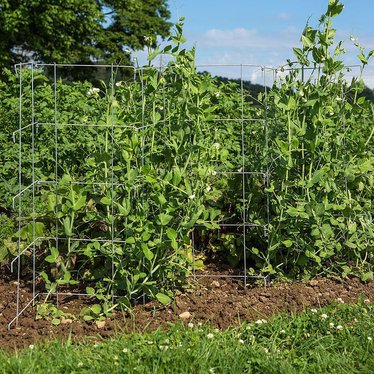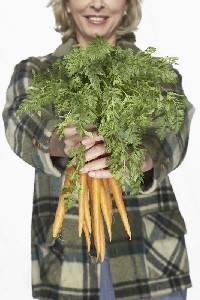
Last year at this time we were looking out at 4+ feet of snow. This year…. well, it’s different.  El nino has seen to that. Today the sun, reflecting off a mere 1 1/2 feet of snow, is streaming in the southern windows. The perky little pepper seedlings are soaking up the warmth. Water drips from the eaves and near foundations, patches of bare earth send wobbly bits of steam upward. I am itching to plant something, itching to taste some “Spring,” but alas, the forecast says we will drop well below freezing and stay there over the next week. I know too, that this far north, even though the days are getting noticeably longer, true Spring won’t arrive until well into April or May. So, if I can’t plant, I will do the next best thing. Put on some sprouts.
El nino has seen to that. Today the sun, reflecting off a mere 1 1/2 feet of snow, is streaming in the southern windows. The perky little pepper seedlings are soaking up the warmth. Water drips from the eaves and near foundations, patches of bare earth send wobbly bits of steam upward. I am itching to plant something, itching to taste some “Spring,” but alas, the forecast says we will drop well below freezing and stay there over the next week. I know too, that this far north, even though the days are getting noticeably longer, true Spring won’t arrive until well into April or May. So, if I can’t plant, I will do the next best thing. Put on some sprouts.
You’ve probably heard of alfalfa sprouts. In fact, the mere mention may trigger memories of deli bars, peace signs, and raggy cut-off jeans. If that is your memory, I would like to introduce you to a different side of sprouting, the micro-green side.

Wouldn’t it be a wonder to nibble on fresh garden peas? Not the market variety that has been picked, packaged, and shipped many miles, leaving its fresh taste somewhere in the dust of travel. But the kind that comes right off the plant with a snap and a bit of a pop as you open the pod. Wouldn’t nibbles of that sort be pleasing to a winter-jaded tongue?
Though the peas themselves may not be possible, the flavor is. I’ll show you how we do it. The tools are simple. In fact, you likely have all the parts right in your kitchen. If you save your own seed, and you have plenty, you may have that in your pantry as well.
 For the pea-sprouting process, you will need a colander or a steamer, something that is solid and has good drainage. I use a steamer that came along with one of my pots. The amount of seed needed is directly related to the size of your steamer. To figure out how much you need, pour the seed into the steamer until it totally covers the bottom of the pot. Next, transfer the seed into a jar and cover to twice its depth with water. Let soak overnight or for about 12 hours. Drain thoroughly. I like to use a sprouting cap but your hand over the jar opening will work fine too. For the next day or two, proceed as you would for small-seeded sprouts, rinsing twice daily and making sure that the seeds drain thoroughly.
For the pea-sprouting process, you will need a colander or a steamer, something that is solid and has good drainage. I use a steamer that came along with one of my pots. The amount of seed needed is directly related to the size of your steamer. To figure out how much you need, pour the seed into the steamer until it totally covers the bottom of the pot. Next, transfer the seed into a jar and cover to twice its depth with water. Let soak overnight or for about 12 hours. Drain thoroughly. I like to use a sprouting cap but your hand over the jar opening will work fine too. For the next day or two, proceed as you would for small-seeded sprouts, rinsing twice daily and making sure that the seeds drain thoroughly.

When the peas have very small sprouts on them, gently spread them in the steamer, being careful not to break the emerging sprouts. Place the steamer in its matching pot (or a bucket), and cover. A solid lid makes a fine cover for the next few days. This keeps the peas in the dark and simulates being underground. While under cover, the peas will first send a root down, followed by a shoot upward. From this point on, you can rinse twice daily by dipping into a bowl of water or by mist spraying. Be very careful to keep the roots moist but not soggy. Depending on how you are “watering” your sprouts, you may need to empty the bottom container frequently so it doesn’t grow bacteria and begin to stink. (Water drained off sprouts is great for watering plants!)
 Once the first true leaves begin to show, expose your pea sprouts to light. I have a glass lid that fits my steamer and this makes it easy to keep the roots moist and let the light in at the same time. When I don’t have a glass lid, I put a piece of plastic wrap loosely over the top. Be diligent with keeping the roots moist so that you will have thick, juicy sprouts.
Once the first true leaves begin to show, expose your pea sprouts to light. I have a glass lid that fits my steamer and this makes it easy to keep the roots moist and let the light in at the same time. When I don’t have a glass lid, I put a piece of plastic wrap loosely over the top. Be diligent with keeping the roots moist so that you will have thick, juicy sprouts.
If you are fortunate to have a sunny day, do put your sprouts in the sun. This will give them opportunity to manufacture even more tasty goodness. While in the sun, remove the cover so you don’t inadvertently cook your little plants.
Keep rinsing or mist spraying until your sprouts are 2-3 inches high.
Depending on the variety of pea seed you have used, the sprouts may have either many small leaves or a few large leaves. Generally speaking, dry or soup peas tend to have the smaller leaves while sweet peas for fresh eating tend to have larger leaves. No matter which variety you have, you will want to snip and enjoy your sprouts before the leaves fully open and become stringy or tough.
 Pea sprouts are delicious raw just as they are, or in salads or sandwiches. They are also very tasty in stir fries, with scrambled eggs, and in soups. Whichever way you choose to use them, you can enjoy their just-picked-from-the-garden fresh pea taste. One of our family favorites is to scramble them with eggs and then pop the mixture into a wrap with spicy canned tomatoes or salsa. Mmmm!
Pea sprouts are delicious raw just as they are, or in salads or sandwiches. They are also very tasty in stir fries, with scrambled eggs, and in soups. Whichever way you choose to use them, you can enjoy their just-picked-from-the-garden fresh pea taste. One of our family favorites is to scramble them with eggs and then pop the mixture into a wrap with spicy canned tomatoes or salsa. Mmmm!
If you are careful to cut just above the first little joint, your peas will come back for a second cutting and sometimes a third before they begin to get stringy. When they are spent add them to your compost or give your chickens a treat.
Sprouting peas is an easy, low-tech way to get your winter greens and enjoy a bit of spring too. Happy sprouting.





























